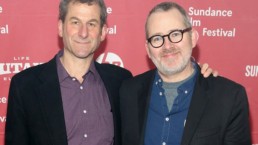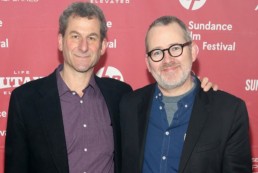Morgan Neville & Robert Gordon on ‘Best of Enemies’
"We were making a film about two guys sitting in a room talking, how do you make that cinematic?" -Morgan Neville
In 1968, ABC News featured two high-profile intellectuals of different political parties, Gore Vidal, and William F. Buckley, Jr., to participate in 10 live debates with each other. What resulted created a new format for pundit television. The documentary Best of Enemies tells this incredible story, and I had the opportunity to talk exclusively with directors Morgan Neville and Robert Gordon about their unusual approach to making this film, the incredible Sundance screening, and how Kelsey Grammer and John Lithgow’s “rare, mid-Atlantic accents” blew them away. We begin:
You both have successful musical backgrounds within filmmaking, were you hesitant to approach a “political” film?
MN: I feel like this film is about culture, and my culture films are about politics. A film like 20 Feet From Stardom talks a lot about race, civil rights, and gender. I don’t see these things as being so distinct. To me, I find a great story and that’s what excites me.
RG: I would say that our music films only use music as an angle into other, bigger topics– social and cultural topics. I understand why people think of this as a departure, but it wasn’t intimidating in that way.
For our review of Best of Enemies, click here.
I have to say, I thought the music in the film was great. A mix of piano, some jazz, it is a pretty intense soundtrack.
RG: We wanted the music to reflect these two men, and they were both classical aficionados, so that was the starting point.
MN: Our big challenge in terms of the filmmaking was that we were making a film about two guys sitting in a room talking, how do you make that cinematic? I felt like we had to use every tool we could to make it feel big, and music is a major part of that. We felt the drama of what was going on in the conversations was operatic and the music had to match that level of drama.
What initially attracted you to this story and these people?
RG: It was the sense of the culture wars we live in being anticipated and expressed by these two guys so long ago.
MN: I just thought it was so… verbal. Haha. I just loved the language, the humor– that was the first thing that got to me. Without understanding where exactly this film would go, I was interested in all of the directions it could go.

Robert, you initially found the footage?
RG: Yeah, a friend of mine shared it with me and I was just wrapped up in it. I called Morgan and he was excited just by the notion of it. We both knew who these people were, we were raised at a time where they were part of the culture, but these debates had kind of slipped from our consciousness. All I had to do with Morgan was say their names and he was excited.
Did you have to narrow down a lot of footage?
RG: Oh yeah, there are 2 1/2 hours of raw debate footage, 10 meetings of 15 minutes each of them in verbal bloodsport.
MN: We had to [cut out a lot] because we didn’t know where the story was going. Nobody had ever written a book about it. The only way we could figure it out was to just keep talking to people, and that’s challenging, but the fun part too. Another big revelation for us was the ABC story, we didn’t know the behind the scenes stuff. That was one of the things that just got better and better the more we went into it.
Yeah, like the roof literally caving in. You can’t write that, it’s too perfect.
MN: I know!
RG: Metaphorical for the network.
I read that you interviewed Gore Vidal in 2010, how long has the span of this project been?
MN: That was the beginning.
RG: Yeah, it began in May 2010. The first round of interviews were kind of a test for the movie. We both knew it was a good idea, but was it going to be affirmed by others? The people who said yes were a way of letting us know we were on the right path.

How did you choose John Lithgow nd Kelsey Grammer to read the voiceovers?
MN: It was a long thought process for us to figure out what to do. It was something we wrestled with, do we do soundalikes? Women? Children? Who reads these voices? And then, I don’t actually remember how, but Kelsey Grammer is a known conservative and that kind of seemed like a natural fit. John Lithgow is a known liberal. They both have those rare, mid-Atlantic accents that completely embody Vidal and Buckley. That’s one of those things you don’t really know how it’s gonna turn out until they do it, and they just blew us away. They brought so much to it.
Their voices sounded familiar, but they weren’t distracting away from the film.
RG: They had the authoritative tone. Those Esquire articles [in the film] contained so much great interior monologue that we knew we had to get them in there.
When you approached them with this movie, were they familiar with the debates?
MN: They knew the men, John knew Gore and Kelsey knew Buckley. Neither of them knew them well. Most young people in 1968 were not home watching TV and because there were no VHS tapes or YouTube, it was something more of lore more than what people actually remembered.

What was your first thought after getting accepted into Sundance?
MN: Yay!
RG: Time to buy some galoshes!
Laughter
MN: This was a five year labor of love and whenever you do something like that, you always wonder if anybody is going to like it. Especially when you work on it in a small, dark room for years. Knowing we got into Sundance was huge, but the first screening at Sundance was probably the pinnacle moment of this whole ride. It was the first time we had proof that what we thought was working, actually was working. The laughter and conversation afterwards exceeded our expectations.
RG: I gotta say, in terms of a Sundance moment, the acceptance was great, but in that first screening in front of 500 people when we had only ever showed it to like 5 or 10 people at once, and never the finished cut to anybody, it was hitting me in my very core. There was a sense of elevation; this is working, the audience is laughing at everything they’re supposed to laugh at. Even the small stuff! It’s sort of like an alchemy moment, we’ve turned this thing and these ideas into something tangible.
Morgan Rojas
Certified fresh. For disclosure purposes, Morgan currently runs PR at PRETTYBIRD and Ventureland.


